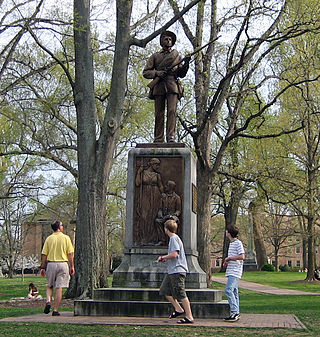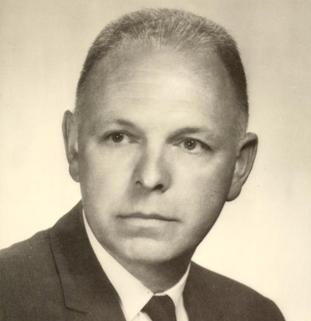
The University of North Carolina at Chapel Hill is a public research university in Chapel Hill, North Carolina. It is the flagship of the University of North Carolina system and is considered to be one of the "Public Ivys". After being chartered in 1789, the university first began enrolling students in 1795, making it one of the oldest public universities in the United States. Among the claimants, the University of North Carolina at Chapel Hill is the only one to have held classes and graduated students as a public university in the eighteenth century.

The Confederate Monument, University of North Carolina, commonly known as Silent Sam, is a bronze statue of a Confederate soldier by Canadian sculptor John A. Wilson, which once stood on McCorkle Place of the University of North Carolina at Chapel Hill (UNC) from 1913 until it was pulled down by protestors on August 20, 2018. Its former location has been described as "the front door" of the university and "a position of honor".

The Greensboro sit-ins were a series of nonviolent protests in February to July 1960, primarily in the Woolworth store—now the International Civil Rights Center and Museum—in Greensboro, North Carolina, which led to the F. W. Woolworth Company department store chain removing its policy of racial segregation in the Southern United States. While not the first sit-in of the civil rights movement, the Greensboro sit-ins were an instrumental action, and also the best-known sit-ins of the civil rights movement. They are considered a catalyst to the subsequent sit-in movement, in which 70,000 people participated. This sit-in was a contributing factor in the formation of the Student Nonviolent Coordinating Committee (SNCC).

The protests of 1968 comprised a worldwide escalation of social conflicts, predominantly characterized by popular rebellions against state militaries and the bureaucracies.

Floyd Bixler McKissick was an American lawyer and civil rights activist. He became the first African-American student at the University of North Carolina School of Law. In 1966 he became leader of CORE, the Congress of Racial Equality, taking over from James Farmer. A supporter of Black Power, he turned CORE into a more radical movement. In 1968, McKissick left CORE to found Soul City in Warren County, North Carolina. He endorsed Richard Nixon for president that year, and the federal government, under President Nixon, supported Soul City. He became a state district court judge in 1990 and died on April 28, 1991. He was a member of Alpha Phi Alpha fraternity.

Joseph Carlyle "Lyle" Sitterson was an American educator who served as chancellor of the University of North Carolina at Chapel Hill from February 16, 1966, to January 31, 1972.

The Charleston hospital strike was a two-month movement in Charleston, South Carolina that protested the unfair and unequal treatment of African American hospital workers. Protests began after twelve black employees were fired for voicing their concerns to the president of Medical College Hospital, which is now the Medical University of South Carolina. The strike was one of the last campaigns of the civil rights movement in South Carolina, and the first of the Southern Christian Leadership Conference since the assassination of Martin Luther King Jr. the year before.
The Black Student Movement (BSM) is an organization at the University of North Carolina at Chapel Hill. It is the second largest student-run organization and one of the largest cultural organizations on the school's campus. The organization was created on November 7, 1967 to combat problems of black recruit, admissions, and integration on UNC-CH campus.

Charles Melvin Sherrod was an American minister and civil rights activist. During the civil rights movement, Sherrod helped found the Albany Movement while serving as field secretary for southwest Georgia for the Student Nonviolent Coordinating Committee. He also participated in the Selma Voting Rights Movement and in many other campaigns of the civil rights movement of that era.
Hocutt v. Wilson, N.C. Super. Ct. (1933) (unreported), was the first attempt to desegregate higher education in the United States. It was initiated by two African American lawyers from Durham, North Carolina, Conrad O. Pearson and Cecil McCoy, with the support of the National Association for the Advancement of Colored People (NAACP). The case was ultimately dismissed for lack of standing, but it served as a test case for challenging the "separate but equal" doctrine in education and was a precursor to Brown v. Board of Education, 347 U.S. 483 (1954).
Immediately following the assassination of Martin Luther King Jr., the Silent Vigil was a social protest at Duke University that not only demanded collective bargaining rights for AFSCME Local 77, the labor union for nonacademic employees, but also advocated against racial discrimination on campus and in the surrounding community of Durham, North Carolina. Occurring from April 4, 1968, to April 12, 1968, members of the University Christian Movement began planning a campus-wide vigil in memoriam of Dr. King. Another group of undergraduate students called for a protest march to address prevalent issues concerning the primarily African-American nonacademic employees at Duke in Local 77. Together, both student groups, along with the support of Local 77, most of the teaching faculty, and civilians not affiliated with the university, sparked a non-violent demonstration that involved over 2,000 participants, making it the largest in Duke's history. The Silent Vigil stands out from other contemporary college movements due to the collaboration between primarily white students and faculty, and mainly African-American workers. Furthermore, unlike rowdier protests at the University of California, Berkeley and Columbia University, Duke's Silent Vigil received considerable praise for its peaceful approach, especially considering its surrounding Southern backdrop. Inspired by the Civil Rights Movement, the Silent Vigil not only aimed to externally change Duke's white, privileged, and apathetic image in the eyes of the Durham community, but also internally set a powerful precedent on Duke's campus for student activism in the future.
The Local 77 chapter of the American Federation of State, County and Municipal Employees is a Duke University labor union established in August 1965. It initially began as the Duke Employees Benevolent Society in February 1965, led by Oliver Harvey. The formation of Local 77 was directed towards improving work conditions for the working class employees, most of whom were African-American. Members fought for minimum wage increases, improvements in working conditions, and medical benefits for employees. The union members of Local 77 demanded a systematic way of dealing with workplace complaints that were impartial to the Duke University administration. Because the majority of the union's members were African-American, several of the goals overlapped with the ideas of the Civil Rights Movement.
The Duke University Hospital unionization drives of the 1970s involved two distinct organizing efforts aimed at uniting the service workers of Duke Hospital. The drives were defined by their fusion of the fight for worker’s rights with the battle for racial equality. The first drive in 1974 was characterized by unity amongst the workers involved, including members of the American Federation of State, County, and Municipal Employees Local 77, and a strong spirit of activism, but failed due to political infighting and resistance by the University. The second drive, organized by a representative of the national American Federation of State, County and Municipal Employees (AFSCME) in 1978, was formed on the ideals of inclusion and keeping the union free of politics. The 1978 drive failed as well, in part due to the management company that Duke hired to instill fear in its workers, and partly due to the overall lack of spirit for organizing. Despite the failure of these drives, they offer a revealing example of the convergence of civil rights and workers rights, highlighting both the status of the civil rights movement in Durham and the difficulty of instigating grassroots-level change in a corporation the size of Duke Hospital, not to mention larger Duke University community.
February One is the name of the 2002 monument dedicated to Ezell Blair Jr., Franklin McCain, Joseph McNeil and David Richmond who were collectively known as the Greensboro Four. The 15-foot bronze and marble monument is located on the western edge of the campus of North Carolina Agricultural and Technical State University in Greensboro, North Carolina. James Barnhill, the sculptor who created the monument, was inspired by the historic 1960 image of the four college aged men leaving the downtown Greensboro Woolworth store after holding a sit-in protest of the company's policy of segregating its lunch counters. The sit-in protests were a significant event in the Civil Rights Movement due to increasing national sentiment of the fight for the civil rights of African-Americans during this period in American history.

David Leinail Richmond was a civil rights activist for most of his life, but he was best known for being one of the Greensboro Four. Richmond was a student at North Carolina A&T during the time of the Greensboro protests, but never ended up graduating from A&T. He felt pressure from the residual celebrity of being one of the Greensboro Four; his life was threatened in Greensboro and he was forced to move to Franklin, NC. Eventually, he moved back to Greensboro to take care of his father. Richmond was awarded the Levi Coffin Award for leadership in human rights by the Greensboro Chamber of Commerce in 1980. Richmond seemed to be haunted by the fact that he could not do more to improve his world, and battled alcoholism and depression. He died in 1990 and was awarded a posthumous honorary doctorate degree from North Carolina A&T

Paul Hardin III was an American academic administrator who spent 27 years as a leader in higher education. He was the chancellor of the University of North Carolina at Chapel Hill from 1988 to 1995, president of Wofford College from 1968 to 1972, of Southern Methodist University from 1972 to 1974, and of Drew University from 1974 to 1988. He was trained as a lawyer at Duke University and at the Duke University Law School.
Prior to the civil rights movement in South Carolina, African Americans in the state had very few political rights. South Carolina briefly had a majority-black government during the Reconstruction era after the Civil War, but with the 1876 inauguration of Governor Wade Hampton III, a Democrat who supported the disenfranchisement of blacks, African Americans in South Carolina struggled to exercise their rights. Poll taxes, literacy tests, and intimidation kept African Americans from voting, and it was virtually impossible for someone to challenge the Democratic Party, which ran unopposed in most state elections for decades. By 1940, the voter registration provisions written into the 1895 constitution effectively limited African-American voters to 3,000—only 0.8 percent of those of voting age in the state.
Velma Hopkins was an American labor rights activist. In 1943 she helped organize a strike against R. J. Reynolds Tobacco Company, which attracted over 10,000 participants from Winston-Salem, North Carolina and led to the founding of the only union to be formed by Reynolds Tobacco employees. Hopkins was a leader in Local 22, a racially integrated union led primarily by Black women. Her efforts in fighting for higher pay and fair treatment made her a leader within the African American community of Winston-Salem.
J. Kenneth Lee (1923-2018) was a prominent civil rights attorney and one of the first black students to attend the University of North Carolina at Chapel Hill's School of Law. Lee was one of four black students who joined a lawsuit in 1949 that would lead to the desegregation of the UNC School of Law.
The 1964–1965 Scripto strike was a labor strike that involved workers for the Scripto company in Atlanta, Georgia, United States. The strike began on November 27, 1964, and lasted until January 9, 1965, when the company and union agreed to a three-year contract that included wage increases and improved employee benefits. The strike was an important event in the history of the civil rights movement, as both civil rights leaders and organized labor activists worked together to support the strike.










